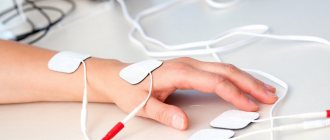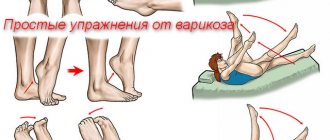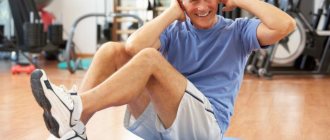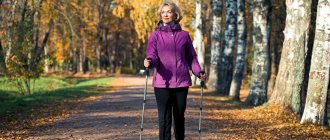A persistent increase in blood pressure today quite often occurs against the background of pathological changes in the cervical vertebrae, leading to ossification of their soft components. Displaced elements of the spine often compress the blood channels leading to the brain. And this, in turn, leads to a deficiency of oxygen in the body and contributes to an increase in the number of contractions of the thick heart muscle.
Due to the last factor, standard blood pressure indicators often change upward, which is not good for any human body.
What is hypertension and why is it dangerous?
Blood pressure (BP) values show how much pressure the blood exerts on the walls of blood vessels when the heart contracts and relaxes.
If the values on the tonometer show figures of 140/90 mm Hg or more, this indicates an increase in blood pressure, and if this condition persists for a long time, it indicates hypertension [1]. Hypertension can occur independently or develop as a consequence of other pathologies - in this case, secondary hypertension develops. If the cause of high blood pressure cannot be eliminated, the disease is chronic and, without proper treatment, constantly progresses [1]. The danger of hypertension lies not in the fact of increased pressure, but in the consequences of this condition. Pathology significantly increases the risk of dangerous cardiovascular disorders - cardiac failure, arrhythmia, heart attack and stroke [2]. Also, against the background of a prolonged increase in blood pressure, damage to the heart, brain structures, kidney vessels, and eyes occurs [1]. A sharp rise in pressure (in some cases - up to 200/120 mm Hg and above) is dangerous due to the risk of a hypertensive crisis - a set of symptoms that develop due to overstrain of the circulatory system at a time of high blood pressure (Fig. 1). This condition can be life-threatening - heart attacks and strokes most often occur precisely at the time of a hypertensive crisis [3].
Figure 1. Signs of a hypertensive crisis. Source: MedPortal
At the same time, the symptoms of hypertension may not appear for a long time - the pathology is called the “silent killer”, since patients often do not measure their blood pressure for years and, accordingly, are not aware of its increase. As the condition worsens, signs of the disease may appear, such as:
- weakness;
- headaches, especially in the morning;
- causeless nosebleeds;
- arrhythmias - complaints of palpitations, irregular heart function;
- deterioration of vision - “loss” of areas of vision, flashing “dots” before the eyes;
- tinnitus.
An intense increase in blood pressure is often accompanied by loss of energy, facial flushing, nausea and vomiting, sweating, anxiety, varying degrees of impaired consciousness, chest pain and other symptoms, but in some cases even a hypertensive crisis can occur asymptomatically [2].
Important! The only way to determine and assess the course of hypertension is to measure blood pressure, so people with this diagnosis need not only to be regularly monitored by a therapist or cardiologist, but also to independently monitor their blood pressure [2].
Treatment of the pathology depends on the type of hypertension - if the pressure rises due to other diseases, it is necessary first of all to restore dysfunction of these organs, and in the primary form of the pathology (hypertension), blood pressure can be normalized only with the help of constant medication and non-drug therapy [2; 3].
How are the human neck and blood pressure related?
The vertebrae of the cervical spine are one of the most mobile parts of the human spine. Thanks to them, a person performs numerous turns of the head from side to side, as well as circular movements with it.
Due to heavy physical activity, the cervical elements of the spine are one of the most vulnerable parts of the human axial skeleton
There are only seven cervical vertebrae in the human body. With osteochondrosis, they often compress the main artery of the axial skeleton, which is responsible for delivering blood to the responsible parts of the brain. As a result, the latter instantly receives a signal about hypoxia, and the human body concentrates as much as possible on preventing oxygen starvation of the most important organ. Vascular tone increases, blood flow increases, and normal blood pressure levels increase.
In most cases, when osteochondrosis suddenly appears, people do not pay close attention to the emerging disease; they neglect treatment and continue to live peacefully. Over time, even the appearance of hypertension becomes normal for them. But in fact, pain in the spine and a diagnosis such as high blood pressure are worth fighting to prevent the development of more serious complications in the future.
In order to cure hypertension, restore the circulation of biological substrates in the body and eliminate deformation of the vessels of the cervical spine, many specialists, in addition to prescribing pills and using any other methods of treatment, recommend their patients to regularly do Alexander Shishonin’s gymnastics.
Conservative treatment for hypertension
To normalize high blood pressure, doctors select drug treatment for patients with hypertension. First of all, the specialist should prescribe a drug from the group of antihypertensive drugs or even a combination of several medications - the choice depends on age, the degree of increase in blood pressure and the stage of the disease.
There are 5 main classes of drugs against hypertension; they are aimed at blocking certain enzymes, ions or receptors of biologically active substances that are involved in the pathogenesis of increased blood pressure. Also included in the list of “first-line” drugs are diuretics - diuretics reduce the volume of blood, as well as intercellular fluid, which reduces the load on the heart and stabilizes pressure in the blood vessels.
It is important for patients to adhere to the rules for treating hypertension, which are relevant in all situations, regardless of the medications prescribed:
- carry out all medical prescriptions;
- Constantly carry out self-monitoring of blood pressure;
- take medications regardless of the numbers on the tonometer - therapy for hypertension is permanent;
- Do not stop taking medications or change dosages on your own [5].
Self-monitoring your blood pressure helps you avoid serious problems caused by hypertension.
Photo: prostooleh - ru.freepik.com Correction of hypertension is not limited to the use of antihypertensive drugs and includes lifestyle changes, stress management and physiotherapy treatments. Therapeutic exercises are also included in the list of mandatory activities for hypertension - special exercises have a multifaceted restorative effect on the body of such patients [4].
How to measure blood pressure using a mechanical tonometer
In order to measure pressure with a mechanical tonometer, you need:
- sit in a comfortable position and relax, while your arm should be bent at the elbow joint and lie on a flat surface,
- remove the shoulder part of the arm from clothing and fasten the cuff on it (its lower edge should be 3-4 cm above the elbow bend),
- place a stethoscope (phonendoscope) on the inside of the elbow joint in the place where the pulse can best be felt,
- using a hand pump, start pumping air into the cuff,
- bring the pressure gauge needle to values exceeding the expected pressure by 30-40 mm. rt. Art. (for example, if the patient’s normal blood pressure is 135/90, then you can stop at 170),
- slowly release air from the cuff, waiting for tones to appear - these are the sounds of a heartbeat; their appearance marks the boundary of systolic pressure, and their disappearance marks the boundary of diastolic pressure. Simply put, if tones appeared at number 150 and disappeared at number 100, then the result is 150/100).
An automatic blood pressure monitor is easier to use (you don’t need to listen to your heart rate yourself), but it is less accurate. Such devices operate on batteries or from the mains.
How hands help open the chest
Another technique is based on the same abdominal breathing. It is necessary, when inhaling, to leave the same key mental image - the movement of energy inside the body, the passage of air into the stomach. In the body, everything will happen in a similar way: due to the expansion of the lower part of the lungs, more absorbed oxygen will be sent to the brain.
The main difference is that you need to complete the movement with your hands. While inhaling, you need to slowly lift them up from your stomach, and then, when your hands are closer to shoulder level, begin to move them apart, describing two wide symmetrical arcs.
It is enough to try this exercise at least once to be convinced of its main positive effect. Due to the movement of the arms, not only the lower, but also the upper part of the chest expands. Of course, in this case, the body manages to absorb and receive even more oxygen in one breath.
- Towards the top point, both hands are at the top, above the level of the head, on both sides of it.
- Immediately after this, you need to exhale and also feel the process. It should bring relief, like the release of some kind of load, heaviness.
- Simultaneously with exhalation, both hands freely descend vertically down on both sides.
- After this, before a new breath begins, the hands are at their lowest point, located close to each other and ready to repeat the cycle.
So, upon completion of the exhalation, you need to feel as much as possible how it brought relief, how the heaviness went away. But there is a fundamental difference here from the first exercise, which was described above. Namely, you need to count ten seconds and maintain one position not while inhaling, but while exhaling.
Having completely relaxed, you should count from one to ten. Only after this does a new breath begin - the cycle repeats. At the same time, the hands begin to move upward from the stomach.
The effectiveness of gymnastics for hypertensive patients
Physiotherapy exercises have long been considered as an effective method for correcting blood pressure and stabilizing the functioning of the circulatory system. Alexander Yuryevich Shishonin, a candidate of medical sciences, a practicing rehabilitation physician and scientist, the head of the clinic that bears his name, and a current member of the New York Academy of Sciences, began his scientific work in this area (Fig. 2). More than 10 years ago, he began developing an effective method for treating hypertension and a number of other diseases using a set of physical exercises [7].
Figure 2. Dr. Shishonin, Ph.D., practicing rehabilitation physician. Source: Doctor Shishonin / YouTube
For the first time, he showed his developments to the whole world at the international medical congress in the USA, after which in 2008 this technique began to be widely used in the treatment of patients with hypertension.
Based on his observations, a bestseller in the field of integrative rehabilitation was published in 2021 - a manual on the treatment of hypertension, which was based on new technologies of cervical-cerebral therapy. The author proved that treatment with gymnastic exercises can effectively reduce blood pressure and maintain the parameters of the heart and blood vessels in normal values [7].
Shishonin’s gymnastics are useful both for the prevention of hypertension and for the correction of high blood pressure. The essence of the technique is to influence the spine, back and chest muscles, as well as the respiratory system.
The specialist developed his program based on objective research methods, including ultrasound of the vessels of the neck and brain structures. This allowed him to determine that an important role in the development of hypertension is played by the displacement of the first vertebra in the cervical spine - the atlas, which causes spasm of the cervical veins and arteries. As a result, blood supply to the brain deteriorates, which signals the heart to work harder. As a result, a “vicious circle” is formed, from which it is possible to get out only by correcting changes in the cervical vertebrae. The developed charging option eliminates pathological compression of neck vessels in order to maintain blood pressure within normal limits [7].
Additional benefits of regular training according to the Shishonin method are:
- strengthening the muscular-articular apparatus;
- normalization of sleep;
- body weight control;
- strengthening bones and increasing joint elasticity;
- improvement of memory and mental activity;
- increased immune activity;
- elimination of unwanted emotional reactions and neuroses [6].
It is recommended to practice the exercises every day in the absence of contraindications - this will prevent the development of hypertensive crises, as well as a number of other diseases and their complications.
In parallel with the exercises, it is necessary to observe additional prevention of the progression of hypertension - get rid of bad habits, monitor nutrition, control emotional reactions to stress, add walks in the fresh air [7].
Diagnostics
The primary diagnosis of radicular syndrome of the lumbosacral spine is made based on the symptoms of the medical history and physical examination (including a thorough examination of the neurological status). A thorough analysis of motor, sensory and reflex functions allows us to determine the level of damage to the nerve root.
If the patient reports typical unilateral radiating leg pain and there are one or more positive neurological test results, then a diagnosis of radiculopathy is very likely.
However, there are a number of conditions that may present with similar symptoms. Differential diagnosis must be carried out with the following conditions:
- Pseudoradicular syndrome
- Traumatic disc injuries in the thoracic spine
- Damage to discs in the lumbosacral region
- Spinal stenosis
- Cauda equina
- Spinal tumors
- Spinal infections
- Inflammatory/metabolic causes - diabetes, ankylosing spondylitis, Paget's disease, arachnoiditis, sarcoidosis
- Trochanteric bursitis
- Intraspinal synovial cysts
To make a clinically reliable diagnosis, as a rule, instrumental diagnostic methods are required:
- X-rays – can detect the presence of joint degeneration, fractures, bone defects, arthritis, tumors or infections.
- MRI is a valuable technique for visualizing morphological changes in soft tissues, including discs, spinal cord and nerve roots.
- CT (MSCT) provides complete information about the morphology of the bone structures of the spine and visualization of spinal structures in cross section.
- EMG (ENMG) Electrodiagnostic (neurophysiological) studies are necessary to exclude other causes of sensory and motor disorders, such as peripheral neuropathy and motor neuron disease
How to do the exercises correctly
Before you begin to repeat the exercises developed by A. Shishonin, you must consult with a specialist. A suitable set of movements for exercise should be selected by a doctor - only he can assess the presence of indications and contraindications for certain types of activity, and clarify the duration and frequency of exercises.
Basic rules for charging:
- For the first 14 days, you need to perform exercises daily, then you can gradually reduce the intensity of the exercise;
- gymnastics can be performed both standing and sitting on a hard surface;
- You should not practice the exercises immediately after eating - at least 1–1.5 hours should pass;
- the initial position of the torso implies a straightened back and stretched neck - this is how all exercises should begin and end;
- all movements must be smooth, “jerks” are not allowed;
- it is important to monitor your breathing - it should be rhythmic, without shortness of breath;
- to effectively stretch the muscles and spine, it is necessary to fix the head at the extreme point for several seconds;
- Between approaches you can rest for 30 seconds in order to tune in to the next exercise;
- the average charging time should be 20–25 minutes;
- If painful sensations occur, stop performing the exercise and move on to other points in the complex [7].
Important! To achieve the best effect, it is necessary to perform exercises regularly - this will not only reduce blood pressure, but also consolidate the result [6].
Often, tangible results appear after the first lesson, and with daily performance of the gymnastic complex, the general condition improves significantly after just a few months. Once the desired results are achieved, you can continue to perform the exercises 2–4 times a week - this is enough for a maintenance effect [7].
Dr. Strelnikova’s complex against hypertension
Doctor Strelnikova, whose methods have long been used by modern cardiologists, also recommended lowering blood pressure with exercises. To achieve tangible results, you need to do gymnastics regularly every day. The course is 2 months.
The basis of the technique is correct breathing.
- Palms. Stand up, fold your arms so that your palms are at shoulder level. Turn your palms forward. Take a powerful breath through your nose, while clench your fists. Exhale and loosen your hands again.
- Shoulder straps. Bend your arms so that your fists are at shoulder level. Inhale loudly, lowering and straightening your arms. Exhale, and enter the I.P.
- Horse. IP - any comfortable position in which the back remains level. Relax, take 4 deep breaths through your nose without interruption. Hold your breath for a couple of seconds and slowly return to the starting position.
- Pump. Place the legs at shoulder level. Bend over so that your back is slightly rounded. Inhale the air forcefully, straighten up, and only then exhale.
- The cat exercise is performed while standing. Bend your elbows and place your palms behind you at lower back level. Take a deep breath and turn to one side. Turn back and exhale calmly. Repeat everything from the beginning, but for the other side. At the same time, breathe noisily and deeply.
- Pendulum. Inhale and bend forward. As you exhale, straighten up and hug yourself with your arms. Turn your neck first in one direction and then in the other. Inhale during the turn, exhale during the starting position.
- Ears. Tilt your head towards one of your shoulders. While bending over, take a deep, powerful breath. Exhale while straightening your neck.
- Pendulum head. Inhale, while tilting your head forward, and as you exhale, return to the i.p.
Interesting! When performing exercises to normalize pressure according to the Strelnikova system, you should pay special attention to proper breathing. Inhalation is done through the nose and exhalation through the mouth. All actions should be performed about 6-8 times. With adaptation to loads, you can increase the number of repetitions. If your health deteriorates, it is better to temporarily interrupt exercise therapy.
Material on the topic: What exercises can you do after a heart attack.
Neck exercises
The main set of exercises consists of 9 simple techniques, which do not require special physical training or even a sports suit.
Exercise "Metronome"
Technique (video 1):
- relax your neck muscles and stretch your head and neck towards your left shoulder;
- tighten the muscles of the shoulder girdle and neck-collar area;
- fix the position for 20–30 seconds;
- return the neck to its original position;
- repeat the technique with the right shoulder;
- perform the exercise at least 5 times on each side.
Video 1. Exercise “Metronome”.
Exercise "Heron"
Technique (video 2):
- raise your hands up;
- spread your arms in different directions;
- stretch your neck forward and raise your head;
- stretch your chin up;
- fix the position for 20–30 seconds;
- return your hands to the starting position.
Video 2. Exercise “Heron”.
Exercise "Tree"
Technique (video 3):
- raise your arms above your head;
- bend your elbows;
- connect your fingertips, turning your palms outward;
- fix this position for 20–30 seconds;
- gently place your hands on your knees;
- repeat lifting at least 5 times.
Video 3. Exercise “Tree”.
Exercise "Fakir"
Technique (video 4):
- raise your hands up;
- connect one palm to the other;
- slowly turn your neck to the left;
- fix the position for 20–30 seconds;
- return the neck to its original position;
- repeat the technique on the other side.
Video 4. Exercise “Fakir”.
Exercise "Frame"
- Technique (video 5):
- turn your neck to the left;
- touch your left palm to your right shoulder;
- keep your elbow parallel to the floor;
- hold the position for 30 seconds;
- return the neck to its original position;
- repeat the exercise on the other side.
Video 5. Exercise “Frame”.
Exercise “Looking at the sky”
Technique (video 6):
- turn your neck to the right to the point of discomfort;
- tighten the muscles of the cervical-collar area;
- fix your head for 30–40 seconds;
- return the neck to its original position;
- repeat the turn in the other direction;
- do the exercise on each side at least 5 times.
Video 6. Exercise “Looking at the Sky.”
Exercise "Goose"
Technique (video 7):
- fix the shoulder girdle;
- stretch your neck forward;
- keep your chin parallel to the floor;
- slowly turn your head to the right side;
- hold the head position for 20–30 seconds;
- return the head to the starting position;
- turn your neck to the left;
- hold the head position for 20–30 seconds;
- return the neck to its original position;
- repeat the exercise on each side 5 times.
Video 7. Exercise “Goose”.
Exercise "Spring"
Technique (video 8):
- relax your neck and gently tilt your head down;
- touch your chin to your chest;
- feel the tension in the neck muscles;
- remain in this position for 10–30 seconds;
- repeat 5 to 10 times.
Video 8. Exercise “Spring”.
Exercise "Airplane"
Technique (video 9):
- fully straighten your arms;
- spread them in different directions until the shoulder blades join;
- hold your hands at shoulder level for 30 seconds;
- put your hands on your knees;
- repeat at least 5 times.
Video 9. Exercise “Airplane”.
The stages of training can be changed depending on your own feelings, and you should also consult a doctor about performing specific movements if they cause severe discomfort.
Complex from Shishonin
Dr. Shishonin offers a set of exercises that effectively develop the muscles of the cervical spine. The basis of exercise therapy is fixing the neck in a certain position. Beginners should remain in the same position for no more than 15 seconds. After regular exercise and strengthening the muscles, the time is increased to 30 seconds. It is better to do gymnastics without sound accompaniment .
The Shishonin method is suitable even for people without sufficient skills and physical training.
The intensity of movements is minimal, so there is no risk of injury. The exercises are so simple that they can be done anytime and anywhere. It will take no more than 20 minutes of free time.
We invite you to watch a video about Dr. Shishonin’s gymnastics and the rules for its implementation:
Massage after exercise
Self-massage helps relax muscles after exercise.
Photo: Racool_studio - ru.freepik.com Dr. A. Shishonin in his works indicates the need to consolidate the effect of gymnastics with the help of self-massage [7]. This procedure additionally warms up the muscles, improves blood flow and oxygen filling of tissues.
But it is important to remember that massage techniques are contraindicated for patients during a hypertensive crisis - the effect on the muscles activates metabolism, and during the procedure you can get the opposite effect - an increase in blood pressure. Also, massage is contraindicated for people with acute inflammatory diseases, skin pathologies, cancer and a number of other pathologies, so the possibility of performing the procedure is determined only by a doctor [7].
The simplest version of self-massage is tapping your knuckles along the neck, kneading the muscles of the shoulder girdle and neck-collar area. With hypertension, all movements must be directed strictly from top to bottom, otherwise a sharp increase in blood flow in the brain structures can lead to the opposite effect - an increase in blood pressure.
Breathing exercises for pressure
Both during exercise and during periods of normal activity, it is important for people with hypertension to be able to breathe correctly. A. Shishonin claims that respiratory movements with high blood pressure should be abdominal, due to movements of the stomach. At the same time, the diaphragm is actively working - the muscle layer that is located between the lungs and the abdominal organs. The abdominal type of breathing helps to naturally lower blood pressure, stabilizes the nervous system, and allows for effective gas exchange and nutrition of all tissues of the body.
Shishonin’s breathing exercises technique includes several stages (video 10):
- take a deep breath from the stomach without expanding the chest;
- holding your breath for 10 seconds;
- calm exhalation;
- repeat the cycle from the beginning at least 15–20 times.
Breathing exercises should be performed for 20–30 minutes daily.
Video 10. Breathing and hypertension.
Preparation
Gymnastics is prescribed by a specialist as an additional procedure against the background of a course of drug therapy. To select the optimal regimen, a comprehensive diagnosis of the patient’s health condition is carried out. The age and results of recent tests of the patient must be taken into account.
And also read on our website: Doctor Evdokimenko - treatment of hypertension without drugs using simple methods
Preparation for gymnastics consists of setting the patient up for active exercise, following the prescribed recommendations and observing the details and conditions during the exercises. Specially selected massage manipulations help restore impaired blood microcirculation in the deepest muscle layers. The desired effect is achieved - congestion and muscle spasm, which are the causes of headaches, are eliminated.
Performing the exercises strictly according to the doctor’s instructions helps not only to have a beneficial effect on the entire musculoskeletal system, but also to involve the internal organs in their work.
Treatment of hypertension in this way is recommended for pregnant women and children who are contraindicated in taking antihypertensive drugs.
Contraindications
Despite the relative safety of the gymnastics complex, there are a number of situations when Shishonin’s exercises should be postponed or even abandoned.
Such restrictions include:
- hypertensive crisis (Fig. 1);
- periods of exacerbation of chronic diseases;
- acute infectious processes;
- exacerbation of cervical osteochondrosis;
- exacerbation of joint diseases, rheumatological diseases;
- recovery period after a stroke or heart attack;
- recent meningitis;
- oncological neoplasms;
- bleeding;
- general exhaustion of the body [7].
It is also important to remember that a set of exercises cannot be considered as an isolated treatment method. Shishonin gymnastics is an effective addition to the main methods of treating hypertension, and exercises from this complex can reduce the number of antihypertensive drugs.
Provoking factors for neck pain
Typically, neck pain occurs due to holding the neck in the same position for too long. However, other factors can also cause or contribute to the development of neck pain, such as:
- anxiety or stress;
- uncomfortable posture during sleep;
- an accident that may cause whiplash;
- sprain of the ligamentous apparatus;
- exacerbation of cervical spondylosis;
Many people experience neck stiffness and pain for no apparent reason. This can happen after sitting in a draft or after minor twisting, such as while gardening. This is called nonspecific neck pain. This is the most common type of neck pain and usually goes away within a few days as long as you continue to move your neck gently and rest when you need to.
Sources
- Clinical guidelines “Arterial hypertension in adults.” Russian Society of Cardiology
- Hypertension. WHO
- Algorithms for managing a patient with hypertensive crisis. All-Russian public organization “Promoting the prevention and treatment of arterial hypertension “Antihypertensive League””.
- Bismak E.V. The effectiveness of using physical rehabilitation means for stage I-II hypertension at the outpatient rehabilitation stage. Phys. education of students creative specialties. — 2008. — No. 3. — P. 9-15
- Algorithms for managing a patient with arterial hypertension and hypertensive crisis. Russian Society of Cardiology
- Gymnastics for hypertension. Clinic of Dr. Shishonin
- Shishonin gymnastics for the neck with cervical osteochondrosis. ANO "Central Clinical Medical Unit"
- Correct breathing for arterial hypertension according to the method of Dr. Shishonin. Shishonin portal. Be healthy with Dr. Shishonin!








